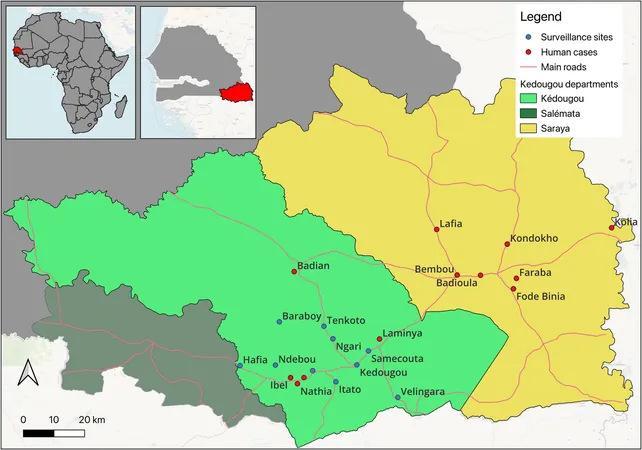
Chikungunya Outbreak Sparks Debate: Is Aedes aegypti Really the Main Culprit?
2025-09-03
Author: Arjun
A New Perspective on Chikungunya Transmission
Chikungunya fever, a debilitating disease spread by mosquitoes, particularly the Aedes species, has been a recurring public health challenge in tropical regions. The recent outbreak in southeastern Senegal during August 2023 prompted researchers to investigate the true vectors of the chikungunya virus (CHIKV) and analyze the strains involved.
Investigative Methods Shine a Light on Mosquito Populations
In response to reported cases, an extensive entomological study was conducted to identify which mosquito species were responsible for the outbreak. Researchers employed various techniques, including sophisticated traps and aspirators, to capture adult mosquitoes from indoor and outdoor locations of impacted households. They also examined water containers for larval stages of these mosquitoes.
Surprising Findings on larval Habitats and Species Distribution
Results revealed that Aedes aegypti larvae were common, but the predominant species collecting the highest numbers of bites and potential infections were Aedes furcifer, primarily found in domestic areas. Out of 31 mosquito pools tested for CHIKV, only one was positive for Aedes aegypti, while a significant 22 detected positives were from Aedes furcifer.
Unraveling the Virus's Genetic Ties
Further genetic analysis demonstrated that the 2023 strain of CHIKV in Kedougou is closely related to strains from past outbreaks in 2005 and 2015. The findings emphasized that the transmission dynamics might have evolved, warranting a re-evaluation of the role of Aedes aegypti as the primary vector.
Broadening the Scope: The Case for Sylvatic Mosquitoes
The study highlights a pressing need for health authorities to widen their surveillance and control measures beyond Aedes aegypti, to monitor sylvatic mosquitoes like Aedes furcifer, which seem to play a critical role in the outbreak. The anomaly of Aedes aegypti's low infection rates despite its ubiquity raises questions about its efficacy as a vector in this region. Additionally, the presence of Anopheles gambiae, primarily known for malaria transmission, adds another layer of complexity—suggesting it might also be involved in CHIKV transmission.
Why is This Important?
Understanding the dynamics of CHIKV transmission is crucial for controlling future outbreaks. Genetic mutations in the virus can alter its transmission capabilities, and factors like climate, immunity, and human interactions can significantly impact its spread. With Senegal's history of cyclical outbreaks, the recent findings demand urgent attention to enhance public health strategies.
Conclusion: A Call for Broader Research
As discussions continue about the roles of different mosquito species in the transmission of chikungunya, this study opens the door for further investigations into the natural history and ecology of arboviruses in Africa. Comprehensive monitoring of both Aedes and Anopheles species could be key to controlling future outbreaks of chikungunya and other emerging infectious diseases.



 Brasil (PT)
Brasil (PT)
 Canada (EN)
Canada (EN)
 Chile (ES)
Chile (ES)
 Česko (CS)
Česko (CS)
 대한민국 (KO)
대한민국 (KO)
 España (ES)
España (ES)
 France (FR)
France (FR)
 Hong Kong (EN)
Hong Kong (EN)
 Italia (IT)
Italia (IT)
 日本 (JA)
日本 (JA)
 Magyarország (HU)
Magyarország (HU)
 Norge (NO)
Norge (NO)
 Polska (PL)
Polska (PL)
 Schweiz (DE)
Schweiz (DE)
 Singapore (EN)
Singapore (EN)
 Sverige (SV)
Sverige (SV)
 Suomi (FI)
Suomi (FI)
 Türkiye (TR)
Türkiye (TR)
 الإمارات العربية المتحدة (AR)
الإمارات العربية المتحدة (AR)